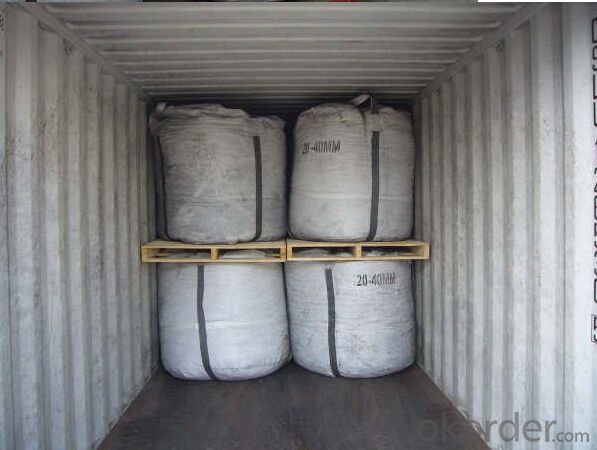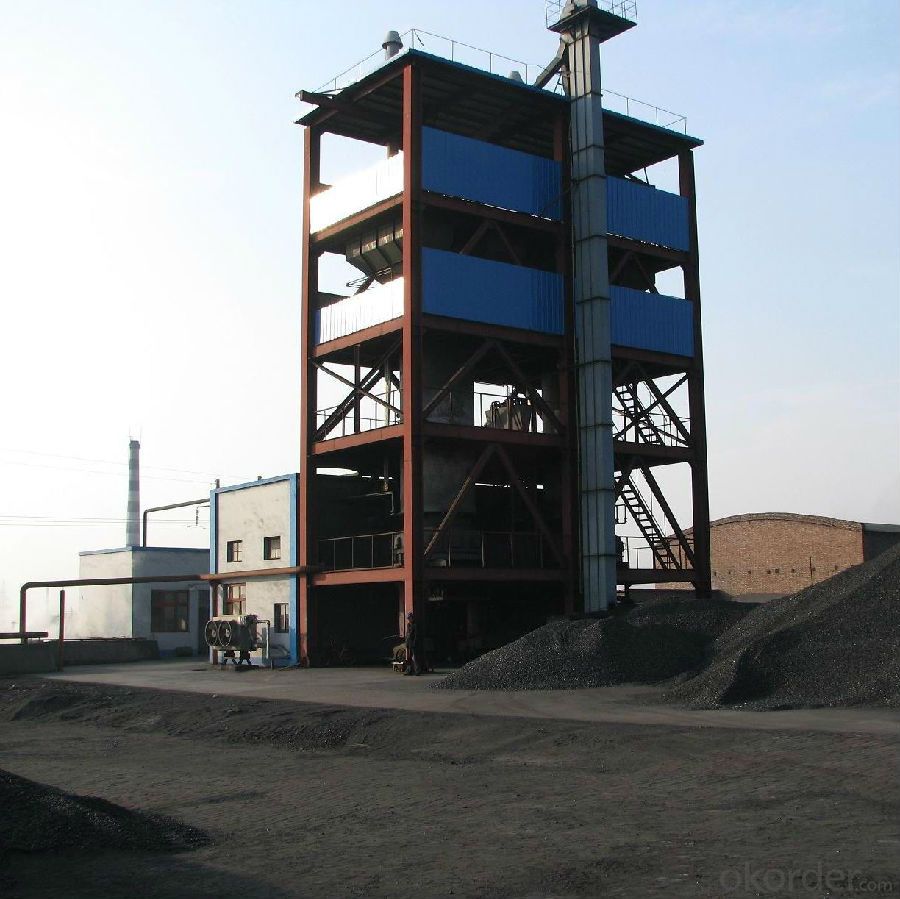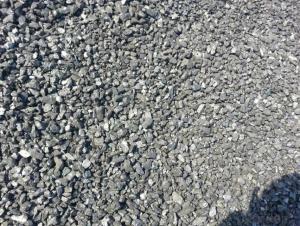Calcined Anthracite Coal with Fixed Carbon 90-95%
- Loading Port:
- Tianjin
- Payment Terms:
- TT OR LC
- Min Order Qty:
- 20 m.t.
- Supply Capability:
- 5000 m.t./month
OKorder Service Pledge
OKorder Financial Service
You Might Also Like
Packaging & Delivery
Calcined Anthracite Coal with Fixed Carbon 90-95%
25kgs/50kgs/1ton per bag or as buyer's request
Specifications
Calcined Anthracite Coal with Fixed Carbon 90-95%
Calcined Anthracite
Fixed carbon: 90%-95%
S: 0.5% max
Size: 0-3. 3-5.3-15 or as request
Product Advantage
Calcined Anthracite Coal with Fixed Carbon 90-95%
It used the high quality anthracite as raw materials through high temperature calcined at over 2000 by the DC electric calciner with results in eliminating the moisture and volatile matter from anthracite efficiently, improving the density and the electric conductivity and strengthening the mechanical strength and anti-oxidation. It has good characteristics with low ash, low resistvity, low sulphur, high carbon and high density. It is the best material for high quality carbon products.
Product Feature:
Calcined Anthracite Coal with Fixed Carbon 90-95%
| FC | 95 | 94 | 93 | 92 | 90 |
| ASH | 4 | 5 | 6 | 6.5 | 8.5 |
| V.M. | 1 | 1 | 1 | 1.5 | 1.5 |
| S | 0.3 | 0.3 | 0.3 | 0.35 | 0.35 |
| MOISTURE | 0.5 | 0.5 | 0.5 | 0.5 | 0.5 |
Pictures
Calcined Anthracite Coal with Fixed Carbon 90-95%



FAQ:
Calcined Anthracite Coal with Fixed Carbon 90-95%
What can we do?
1.High quality and competitive price.
2.Timely delivery.
3.If any item you like. Please contact us.
Your sincere inquiries are typically answered within 24 hours.
so-font-kerning: 0'>2.Timely delivery.
3.If any item you like. Please contact us.
Your sincere inquiries are typically answered within 24 hours.
- Q:What is the atomic weight of carbon?
- The atomic weight of carbon is approximately 12 atomic mass units.
- Q:What is carbon black dye?
- Carbon black dye is a pigment derived from the incomplete combustion of hydrocarbons, commonly used in various industries, including the production of inks, plastics, rubber, and coatings.
- Q:What is the boiling point of carbon?
- The boiling point of carbon, a nonmetallic element, depends on its allotrope. Carbon has multiple allotropes, including graphite and diamond, each with different physical properties. Graphite, which consists of layers of carbon atoms arranged in a hexagonal lattice, does not have a boiling point since it sublimes directly from a solid to a gas. On the other hand, diamond, which is composed of carbon atoms arranged in a three-dimensional lattice, also does not have a boiling point as it undergoes direct sublimation. Therefore, carbon does not have a boiling point in its pure elemental form.
- Q:Can carbon be recycled?
- Yes, carbon can be recycled.
- Q:What is carbon capture and storage?
- Carbon capture and storage (CCS) is a process that involves capturing carbon dioxide emissions from industrial sources, such as power plants, and storing them underground or using them for various purposes. It aims to mitigate the release of greenhouse gases into the atmosphere, helping to combat climate change by reducing carbon dioxide levels.
- Q:What are the implications of melting permafrost on carbon emissions?
- The melting of permafrost has significant and concerning implications for carbon emissions. Permafrost, which is permanently frozen ground found in cold regions, consists of soil, rocks, and organic matter. It acts as a large carbon sink, storing vast amounts of organic material, such as dead plants and animals, which have been frozen for thousands of years. However, as global temperatures rise, permafrost is thawing at an alarming rate, which could potentially release this stored carbon into the atmosphere. When permafrost thaws, the organic matter contained within it decomposes, releasing greenhouse gases, particularly carbon dioxide (CO2) and methane (CH4), into the atmosphere. Methane is an extremely potent greenhouse gas, with a global warming potential over 25 times greater than that of CO2 over a 100-year period. The release of these gases further contributes to climate change, exacerbating the already accelerating warming trend. The implications of melting permafrost on carbon emissions are twofold. Firstly, the release of large amounts of CO2 and methane from thawing permafrost can significantly amplify the greenhouse effect, leading to more rapid and intense climate change. This can create a feedback loop, where increased warming causes more permafrost thawing, releasing more carbon, and further accelerating global warming. Secondly, the release of carbon from permafrost also affects global carbon budgets and efforts to mitigate climate change. The amount of stored carbon in permafrost is estimated to be twice as much as what is currently present in the Earth's atmosphere. As this carbon is released, it adds to overall carbon emissions, making it more challenging to achieve emission reduction targets outlined in international agreements, such as the Paris Agreement. It also means that efforts to limit global warming to well below 2 degrees Celsius above pre-industrial levels become even more crucial. Moreover, the release of carbon from permafrost also has implications for local ecosystems and communities. Thawing permafrost can lead to the destabilization of infrastructure, including buildings, roads, and pipelines, as well as disrupt traditional livelihoods, such as hunting and reindeer herding. It can also cause land subsidence and increased coastal erosion, posing threats to coastal communities and biodiversity. In conclusion, the implications of melting permafrost on carbon emissions are extensive. It not only exacerbates climate change by releasing potent greenhouse gases into the atmosphere but also hinders global efforts to mitigate carbon emissions. Taking sustainable actions to reduce greenhouse gas emissions and protect permafrost ecosystems are vital to minimize these implications and safeguard the future of our planet.
- Q:What are the carbon monoxide collection methods?
- Drainage method.Because the density of carbon monoxide is almost the same as the density of air, it is difficult to obtain pure carbon monoxide by exhaust air.
- Q:What are the main factors that affect the strength of carbon fibers?
- The main factors affecting the strength of carbon fibers arePAN precursorPreoxidationcarbonizationGraphitizationsurface treatmentCoilingcarbon fibre
- Q:What is carbon neutral certification?
- Carbon neutral certification is a recognition given to individuals, organizations, or products that have successfully reduced their carbon footprint to zero by balancing their greenhouse gas emissions with an equivalent amount of carbon offsets or renewable energy. It signifies a commitment to mitigating the negative environmental impact and contributing to a more sustainable future.
- Q:What are the effects of carbon emissions on the stability of coastal ecosystems?
- Coastal ecosystems are significantly affected by carbon emissions, resulting in various consequences. Ocean acidification, caused by excess carbon dioxide dissolving in seawater and lowering its pH, is one of the primary effects. This acidification harms marine organisms, especially those dependent on calcium carbonate for shell formation, such as corals, oysters, and some plankton. With increased acidity, the ability of these organisms to create and maintain their protective structures is hindered, leading to slower growth, weaker shells, and heightened vulnerability to predation and disease. Furthermore, global warming, which is exacerbated by carbon emissions, leads to rising sea levels and more intense storms. Coastal ecosystems like mangroves, salt marshes, and seagrass beds serve as barriers against storm surges and provide vital habitats for numerous species. However, as sea levels rise, these ecosystems face the risk of submersion, resulting in the loss of their protective functions and the displacement of various plant and animal species. In addition, carbon emissions-driven climate change disrupts ocean currents and disturbs nutrient balances in coastal waters. This disturbance can cause shifts in the distribution and abundance of marine species, affecting the entire food chain. For example, if certain species that serve as prey or predators are negatively impacted, it can create a ripple effect throughout the ecosystem. These disruptions ultimately lead to reduced biodiversity, the loss of crucial species, and the potential collapse of entire coastal ecosystems. To safeguard these fragile ecosystems and the countless species that depend on them, it is imperative to reduce carbon emissions and mitigate the impacts of climate change.
1. Manufacturer Overview |
|
|---|---|
| Location | |
| Year Established | |
| Annual Output Value | |
| Main Markets | |
| Company Certifications | |
2. Manufacturer Certificates |
|
|---|---|
| a) Certification Name | |
| Range | |
| Reference | |
| Validity Period | |
3. Manufacturer Capability |
|
|---|---|
| a)Trade Capacity | |
| Nearest Port | |
| Export Percentage | |
| No.of Employees in Trade Department | |
| Language Spoken: | |
| b)Factory Information | |
| Factory Size: | |
| No. of Production Lines | |
| Contract Manufacturing | |
| Product Price Range | |
Send your message to us
Calcined Anthracite Coal with Fixed Carbon 90-95%
- Loading Port:
- Tianjin
- Payment Terms:
- TT OR LC
- Min Order Qty:
- 20 m.t.
- Supply Capability:
- 5000 m.t./month
OKorder Service Pledge
OKorder Financial Service
Similar products
New products
Hot products
Hot Searches































